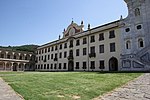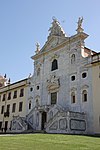Calci
| Calci | ||
|---|---|---|

|
|
|
| Country | Italy | |
| region | Tuscany | |
| province | Pisa (PI) | |
| Coordinates | 43 ° 43 ' N , 10 ° 31' E | |
| height | 50 m slm | |
| surface | 25.16 km² | |
| Residents | 6,322 (Dec. 31, 2019) | |
| Population density | 251 inhabitants / km² | |
| Post Code | 56011 | |
| prefix | 050 | |
| ISTAT number | 050003 | |
| Popular name | Calcesani | |
| Patron saint | Sant'Ermolao di Nicomedia (August 7th) | |
| Website | Calci municipality | |
 Panorama of Calci |
||
Calci is an Italian commune with 6,322 inhabitants (as of December 31, 2019) in the Tuscany region . It is in the province of Pisa .
geography
The municipality is located about 60 km west of the regional capital Florence and about 10 km east of the provincial capital Pisa in the small valley Valgraziosa, at the foot of the range of hills of Monte Pisano below and southwest of Monte Serra in the climatic classification of Italian communities in zone D, 1 628 GR / G. The Zambra river divides the place and shortly after flows into the Arno .
The districts include Gabella (14 m , approx. 850 inhabitants), Montemagno (198 m, approx. 350 inhabitants), Tiricella (225 m, approx. 50 inhabitants) and Villa (150 m, approx. 40 inhabitants).
The places Castelmaggiore , Il Colle , La Corte , La Pieve , Pontegrande , Rezzano and Tre Colli are considered to be Borgo (suburb) and administratively belong to the main town.
The neighboring municipalities are Buti , Capannori ( LU ), San Giuliano Terme and Vicopisano .
history
In Roman times the place was called Locus Calcis (of lat . Calcis for limestone ), which points to the numerous quarries nearby. The place was first mentioned on April 30, 780 in a document from the nearby Abbey of San Savino (Badia di San Savino). In the Middle Ages the area belonged to the Bishop of Pisa. Several monasteries were founded, and the place lived from agriculture (as it is still today mainly olive cultivation ) and textile production (wool). The forests provided wood for the shipyards of the Maritime Republic of Pisa . Today the community is a popular place to live in the Pisas catchment area. Agrotourism is an important economic factor .
Culture and sights
-
Certosa di Pisa , Charterhouse in the immediate vicinity of the center of Calci. It was founded in 1366 and is one of the largest monasteries in Tuscany. In the church of the monastery (Cappella di San Bruno) is the canvas painting San Bruno in gloria by Jacopo Vignali. The Chiostrino Capitolare houses the fresco Ultima cena (The Last Supper) by Bernardino Poccetti (created in 1597). The interior was rebuilt from 1765 to 1795 by the architect Nicola Stassi and decorated with baroque frescoes. Today the monastery is a museum.
- Museo di Storia Naturale e del Territorio of the University of Pisa . The natural history museum is housed in part of the monastery building. It shows geological, botanical and zoological collections. A large gallery with 24 whale skeletons is interesting.
Blue whale skeleton in the museum
- Pieve dei Santissimi Giovanni ed Ermolao , Pieve , built in the 11th century, first mentioned in 1116, has a facade in the style of the Pisan Romanesque . The campanile was never completed. The marble baptismal font is from the 12th century. The church also contains two works by Aurelio Lomi (1556–1622), the work Madonna col Bambino by Cecco di Pietro (panel) and a painted wooden cross from the 12th century.
- San Piero alle Corti , church on the edge of the town center. First mentioned in 1372 as San Pietro in Cerbaia and completely restored in 1952/1953 due to war damage.
- Chiesa e convento di Sant'Agostino (built from 1258 to 1264) in the Località Nicosia, which was created by Ugo da Fagiano, Bishop of Nicosia , as well as the Santuario della Madonna delle Grazie , also San Bartolomeo Apostolo in Tre Colli , sanctuary in the Borgo Tre Colli, whose church was probably built in the 11th century and was initially dedicated to San Bartolomeo . The campanile emerged from the local tower that was destroyed by Pisa in 1288 and contains a bell by Nicolò Bondi from 1392.
- San Michele Arcangelo , church in the district of Castelmaggiore, first documented mention in 1023 and enlarged in 1827.
- San Salvatore , church in the district of Colle, first mentioned in 1292.
- San Rocco , oratory in the Colle district, between Calci, Colle and Sant'Andrea. Made in 1630.
- Sant'Andrea , 11th century church in Sant'Andrea a Lama.
- Santa Maria ad Nives , church in the Montemagno district, built in the 11th century.
- San Lorenzo al Sasso , oratory in the Montemagno district. Founded in the 18th century by the Coli e Pierini family to replace the 12th century church.
- San Martino , church in the district of Montemagno, first mentioned in the 13th century.
- Villa Rosselmini , a building mentioned as early as 1682 with three gardens south of the town center in Via Rosselmini 10.
- Villa di Crespignano near the Rocca Caprona castle (the castle is now part of the municipality of Vicopisano) and the Arno. The villa was built in the 17th century by the Lanfranchi Lanfreducci family and was significantly redesigned in 1746 by the architect Ignazio Pellegrini.
literature
- Emanuele Repetti: CALCI nel Val d'Arno pisano. In: Dizionario Geografico Fisico Storico della Toscana (1833–1846) , online edition of the University of Siena (pdf, Italian).
- Mario E Martini: La storia di Calci. Raccolta di notizie, edite ed inedite, intorno a luoghi, cose, persone e fatti della Valle Graziosa. Pisa 1976, 585 pp.
- Touring Club Italiano : Toscana. Milan 2003, ISBN 88-365-2767-1 , p. 394 ff.
Web links
- Website of the municipality of Calci (Italian)
- Website of the Museo di Storia Naturale dell'Università di Pisa in Calci (English)
Individual evidence
- ↑ Statistiche demografiche ISTAT. Monthly population statistics of the Istituto Nazionale di Statistica , as of December 31 of 2019.
- ↑ Website of the Agenzia nazionale per le nuove tecnologie, l'energia e lo sviluppo economico sostenibile (ENEA), accessed on January 30, 2013 (Italian) (PDF; 330 kB)
- ^ A b Emanuele Repetti: CALCI nel Val d'Arno pisano.
- ↑ Official website of the ISTAT ( Istituto Nazionale di Statistica ) on 2001 population figures in the province of Pisa, accessed on February 1, 2012 (Italian)
- ↑ a b c cf. TCI
- ^ Emilia Daniele, Paolo Bertoncini Sabatini: L'arte di abitare in Toscana. Edizioni Polistampa, Florence 2011, ISBN 978-88-596-0839-4 , p. 77
- ↑ a b I luoghi della Fede of the Regione Toscana , web archive
- ↑ Chiese Italiane: Chiesa di San Piero alle Corti <Calci> , Ufficio Nazionale per i beni culturali ecclesiastici e l'edilizia di culto e Servizio Informatico della Conferenza Episcopale Italiana, accessed on February 28, 2018 (Italian)
- ↑ Chiese Italiane: Chiesa di San Bartolomeo Apostolo in Tre Colli <Castelmaggiore, Calci> , Ufficio Nazionale per i beni culturali ecclesiastici e l'edilizia di culto e Servizio Informatico della Conferenza Episcopale Italiana, accessed on February 28, 2018 (Italian)
- ↑ Chiese Italiane: Chiesa di San Michele Arcangelo <Castelmaggiore, Calci> , Ufficio Nazionale per i beni culturali ecclesiastici e l'edilizia di culto e Servizio Informatico della Conferenza Episcopale Italiana, accessed on February 27, 2018 (Italian)
- ↑ Chiese Italiane: Chiesa di San Salvatore <Colle di Calci, Calci> , Ufficio Nazionale per i beni culturali ecclesiastici e l'edilizia di culto e Servizio Informatico della Conferenza Episcopale Italiana, accessed on February 27, 2018 (Italian)
- ↑ Chiese Italiane: Oratorio di San Rocco <Colle di Calci, Calci> , Ufficio Nazionale per i beni culturali ecclesiastici e l'edilizia di culto e Servizio Informatico della Conferenza Episcopale Italiana, accessed on February 27, 2018 (Italian)
- ↑ Chiese Italiane: Chiesa di Sant'Andrea Apostolo <Sant'Andrea a Lama, Calci> , Ufficio Nazionale per i beni culturali ecclesiastici e l'edilizia di culto e Servizio Informatico della Conferenza Episcopale Italiana, accessed on February 28, 2018 (Italian)
- ↑ Chiese Italiane: Chiesa di Santa Maria ad Nives <Montemagno, Calci> , Ufficio Nazionale per i beni culturali ecclesiastici e l'edilizia di culto e Servizio Informatico della Conferenza Episcopale Italiana, accessed on February 28, 2018 (Italian)
- ↑ Chiese Italiane: Oratorio di San Lorenzo al Sasso <Montemagno, Calci> , Ufficio Nazionale per i beni culturali ecclesiastici e l'edilizia di culto e Servizio Informatico della Conferenza Episcopale Italiana, accessed on February 28, 2018 (Italian)
- ↑ Chiese Italiane: Chiesa di San Martino <Montemagno, Calci> , Ufficio Nazionale per i beni culturali ecclesiastici e l'edilizia di culto e Servizio Informatico della Conferenza Episcopale Italiana, accessed on February 28, 2018 (Italian)
- ^ Ovidio Guaita: Le Ville della Toscana , Newton & Compton Editori, Rome 1997, ISBN 88-8183-787-0 , p. 234 f.
- ^ Ovidio Guaita: Le Ville della Toscana , Newton & Compton Editori, Rome 1997, ISBN 88-8183-787-0 , p. 191 ff.











